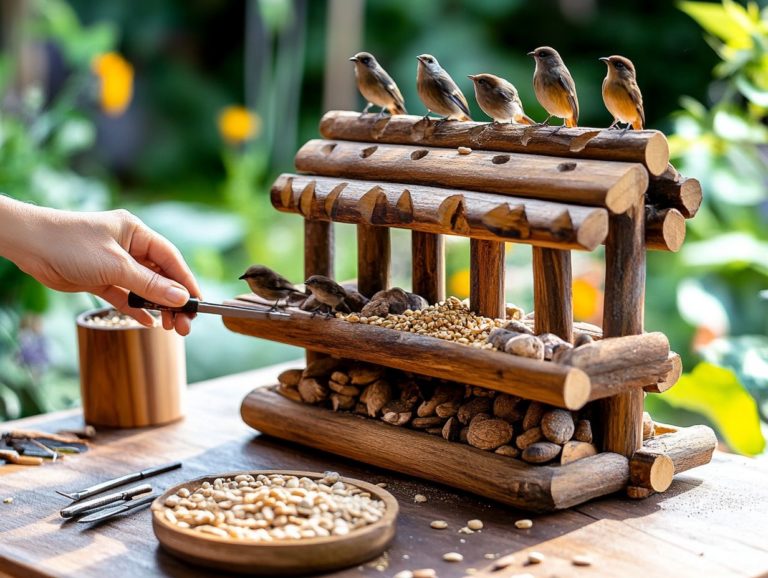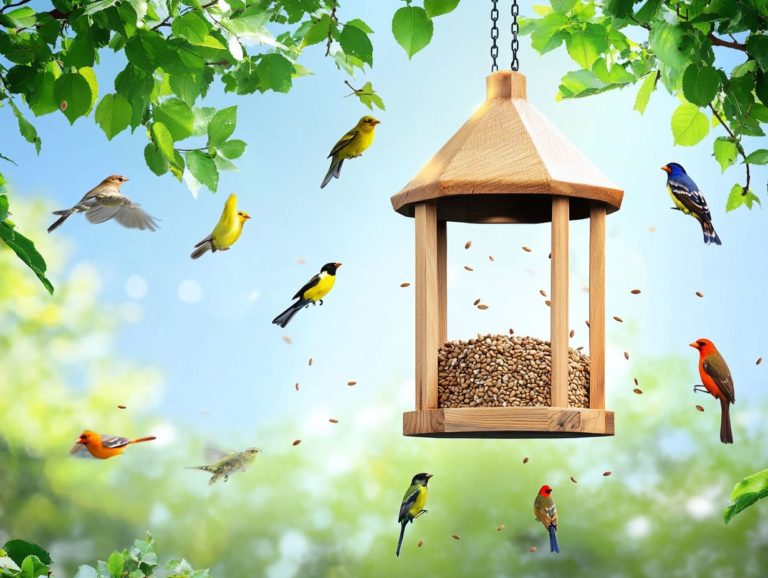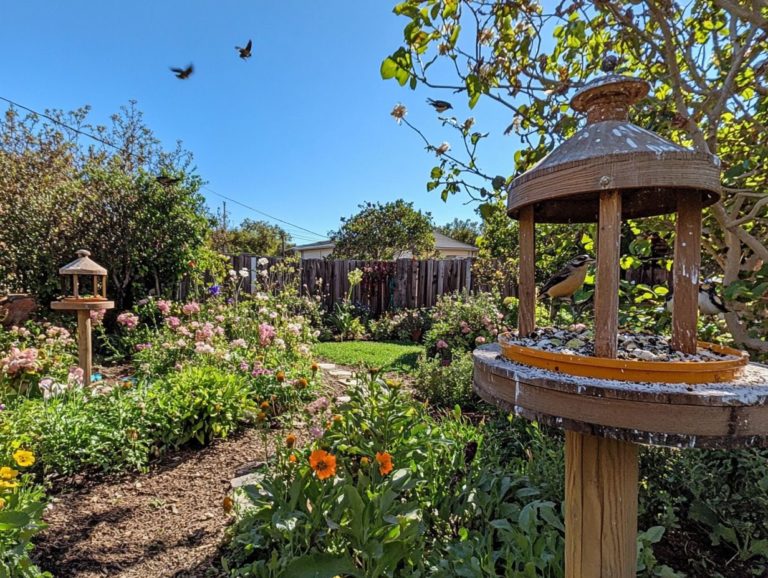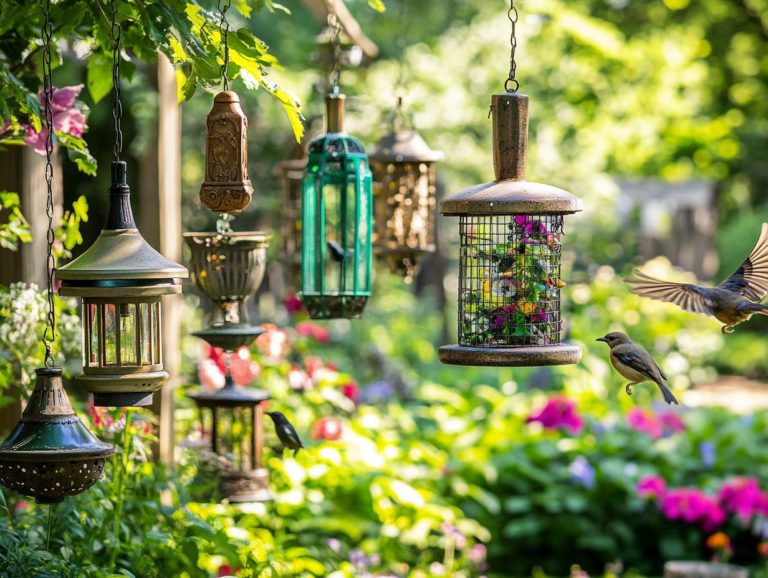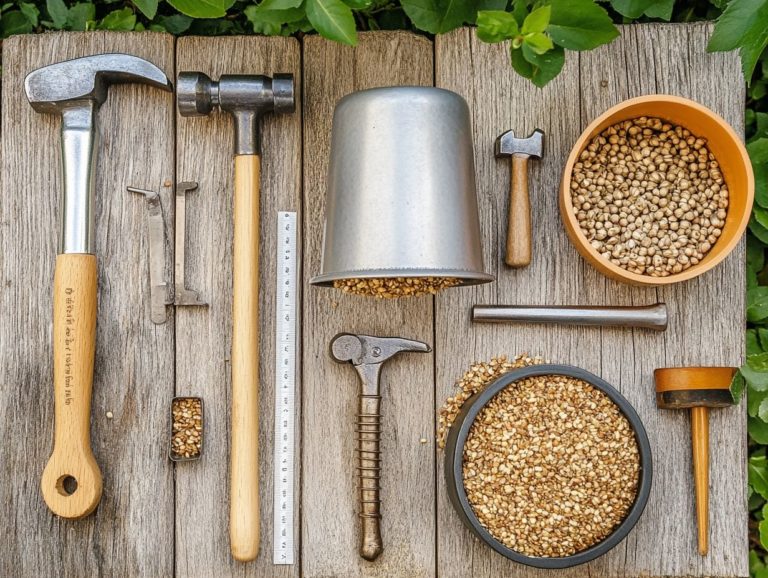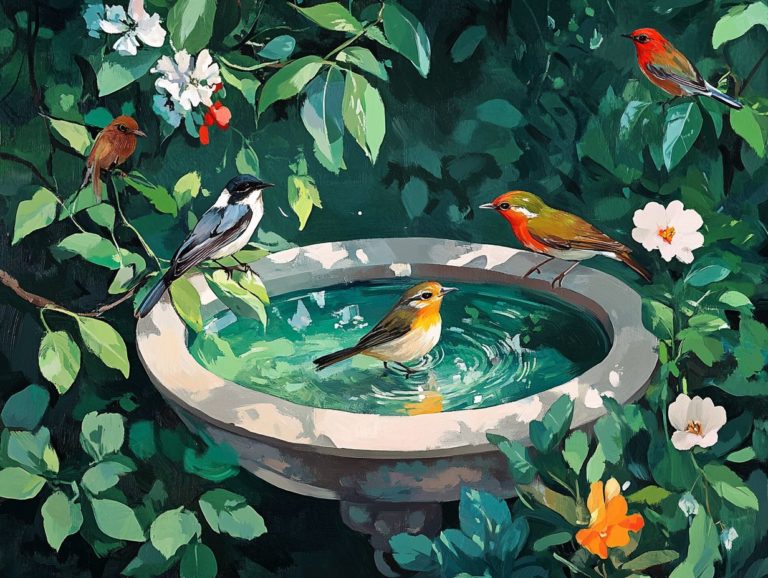Understanding Bird Feeder Preferences
Bird feeders offer a charming opportunity for you to connect with nature. They draw a delightful array of feathered friends to your yard.
Each bird species has its own unique preferences regarding feeders and food. Understanding what works best is essential. This article delves into the key factors that influence bird feeder choices, highlighting the types of birds you can attract and the various feeders available to you.
You ll discover tips for creating an inviting environment that encourages a diverse range of species to visit your setup. Get ready to elevate your birdwatching experience!
Contents
- Key Takeaways:
- Factors that Influence Bird Feeder Preferences
- Common Bird Feeder Preferences
- Tips for Attracting Birds to Your Feeder
- Frequently Asked Questions
- What factors should I consider when understanding bird feeder preferences?
- Do Different Bird Species Have Specific Feeder Preferences?
- What Types of Food Should I Offer in My Bird Feeder?
- Can the Location of My Bird Feeder Affect Its Popularity?
- How Can I Make My Bird Feeder More Appealing to Birds?
- Are There Any Specific Design Features I Should Look for in a Bird Feeder?
Key Takeaways:
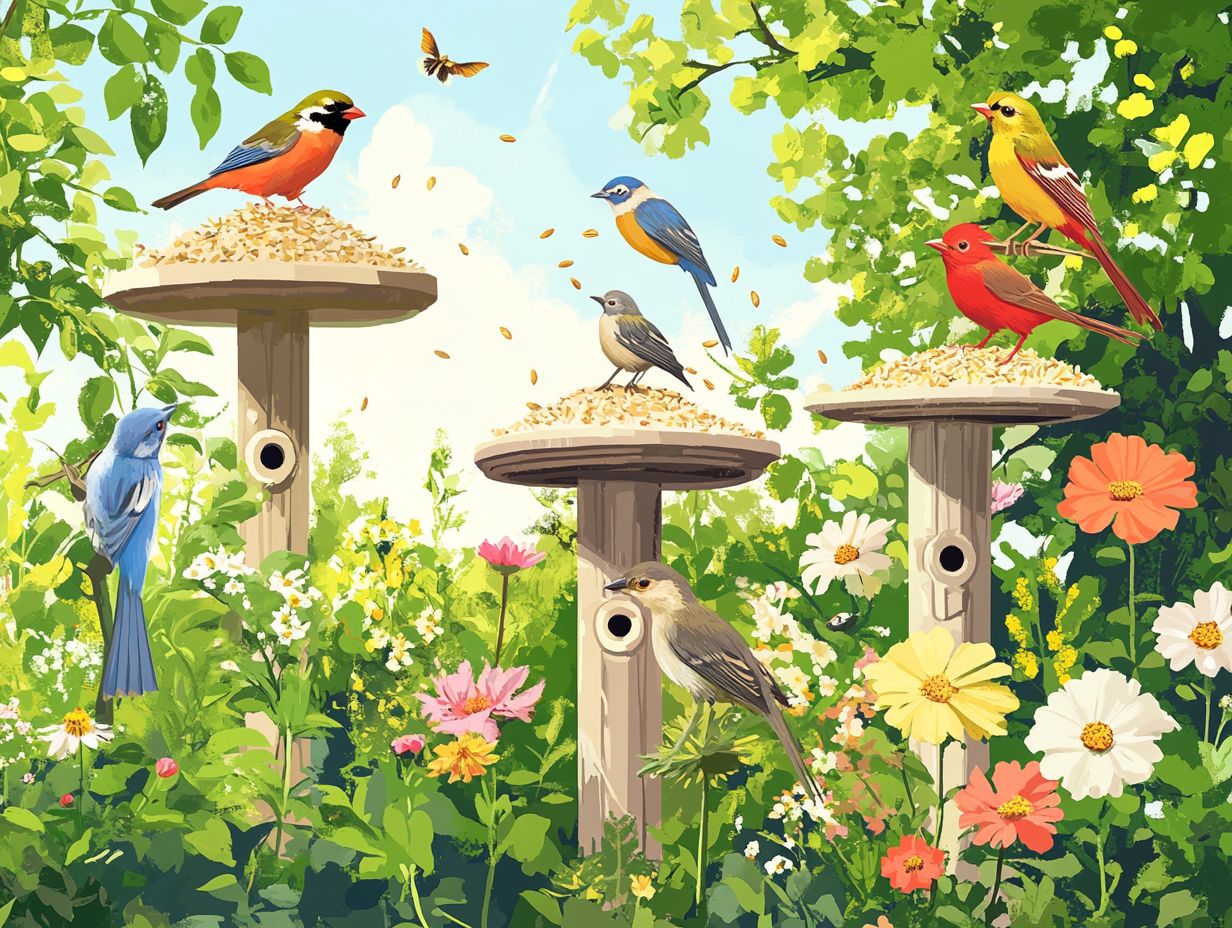
- Understanding bird feeder preferences can help attract a variety of bird species to your feeder.
- Factors like bird species, feeder type, and location influence bird feeder preferences.
- Creating a welcoming environment and offering a variety of foods and feeders can increase bird activity at your feeder.
What are Bird Feeders?
Bird feeders are devices designed to provide food for birds in your backyard. They enhance your wildlife experience and allow you to observe various bird species.
With many designs catering to different food types and bird preferences, these feeders play a crucial role in supporting bird populations. This is especially important during times of the year when birds feed heavily, like winter, when natural food sources may dwindle.
By adding feeding stations to your outdoor space, you can attract a diverse range of birds and closely observe their feeding behaviors. Different feeder types like tube, platform, and suet feeders are tailored for specific species.
This invites charming visitors like finches, sparrows, and woodpeckers into your garden. Offering seed mixtures, suet, and nectar for hummingbirds adds delightful variety to their diet and helps meet their nutritional needs during migration and nesting seasons.
Setting up multiple feeders around your property creates a vibrant atmosphere. It provides you with an engaging opportunity to study feeding habits and social interactions among different species.
This wonderful addition brings joy to your garden while playing a vital role in supporting local ecosystems by nurturing healthy bird populations.
Factors that Influence Bird Feeder Preferences
Bird feeder preferences among different bird species are shaped by many factors, including their natural diets, feeding habits, and environmental conditions. To learn more about this, check out what types of bird feeders attract more birds.
Distinct food preferences determine which feeders will attract various species, such as goldfinches, sparrows, and cardinals. For example, elevated feeders may cater to certain birds’ inclinations, while ground feeding might entice others.
Types of Birds
The array of birds that frequent feeders is remarkable, featuring many songbird species such as hummingbirds, goldfinches, sparrows, and cardinals. Each has unique feeding habits and preferences.
Hummingbirds, for example, are drawn to nectar-rich delights, showcasing their impressive hovering skills as they feed. Goldfinches prefer nyjer or sunflower seeds, often seen deftly clinging to feeders or foraging among nearby plants.
Sparrows enjoy seeds scattered on the ground, relishing a more down-to-earth dining approach. Cardinals captivate with their striking plumage and favor larger seeds like sunflower hearts.
These dietary preferences underscore the importance of selecting the right feeders. Using tube feeders for hummingbirds, platform feeders for sparrows, and hopper feeders for cardinals can significantly enhance the variety of birds that grace your feeding station.
So, grab your bird feeder today and watch your backyard come alive with vibrant feathered visitors!
Types of Feeders
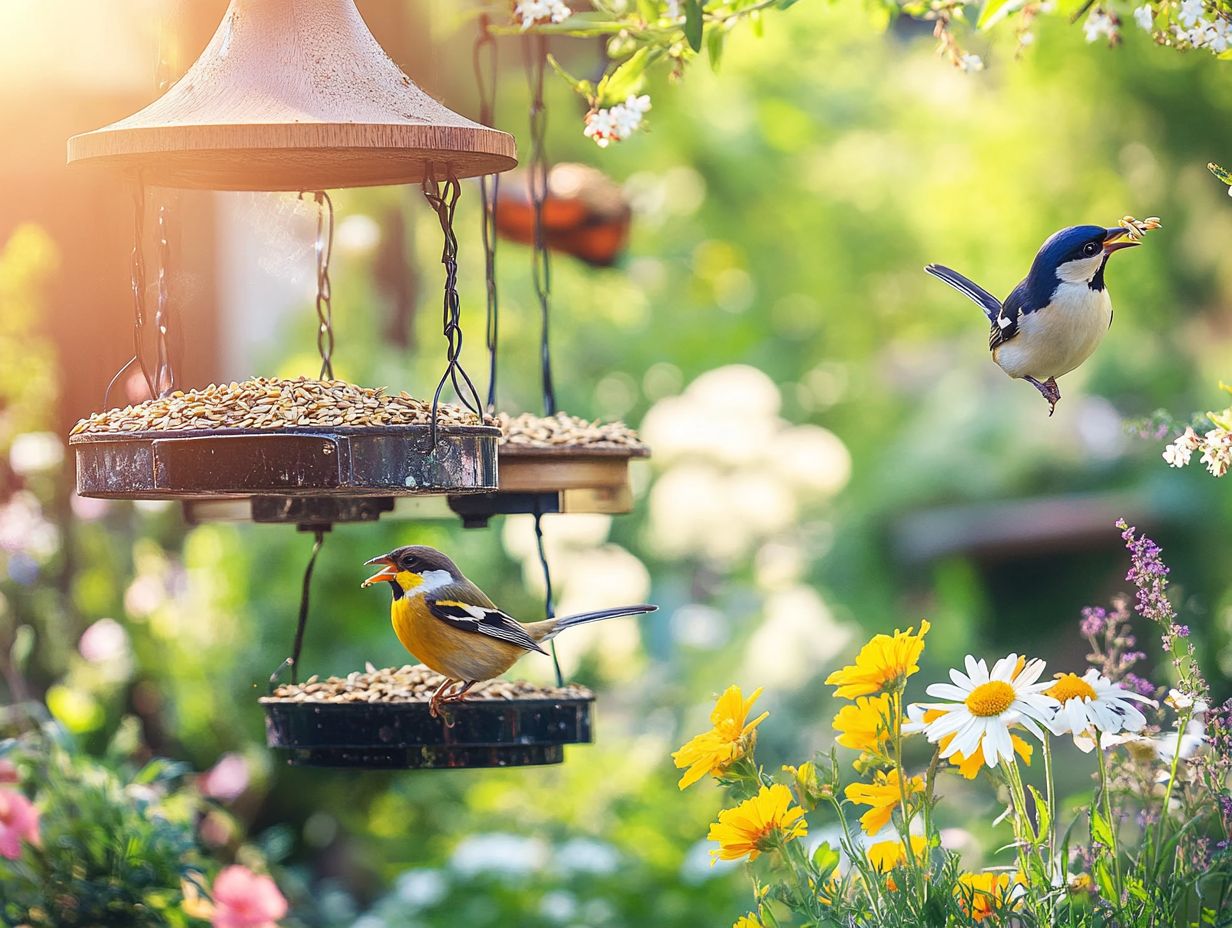
There are several types of bird feeders designed to attract certain types of birds and accommodate different food types. Elevated feeders are perfect for larger birds, while ground feeders cater to those that prefer dining closer to the ground.
The placement of your feeders is essential for attracting birds. It helps keep them safe from predators and maximizes the number of feathered visitors to your backyard sanctuary.
Tube feeders are particularly popular for hosting small seeds like nyjer, drawing in charming finches and smaller songbirds. In contrast, suet feeders entice woodpeckers and other insect-loving species. Each feeder is thoughtfully designed with features like drainage holes to keep the feed dry, along with materials that are easy to clean and built to last.
By understanding the feeding behaviors of local birds, you can make informed decisions about the types and placements of your feeders. This knowledge helps you create a diverse and inviting feeding environment. Position your feeders away from known hunting grounds for cats or raccoons to enhance safety, ensuring that every meal is a delightful experience for your backyard birds.
Location and Environment
The location and environment of your bird feeders greatly impact their ability to attract visitors. Factors like safe cover, proximity to natural food sources, and the surrounding habitat are crucial. Whether you’re in a suburban setting or a rural retreat, crafting a welcoming environment with suitable vegetation while minimizing wildlife conflicts is key to attracting birds.
Birds naturally gravitate to areas that offer shelter from predators and harsh weather. This allows them to feel secure while they dine. Enriching your backyard habitat with native plants not only provides a natural food source but also draws a diverse range of bird species.
When placing your feeders, avoid spots that might expose birds to danger like busy roads or areas where cats roam. This thoughtful positioning enhances their comfort and safety.
By understanding these details, you can cultivate a thriving bird population, transforming your outdoor space into a vibrant sanctuary for wildlife.
Common Bird Feeder Preferences
Bird feeder preferences can vary significantly among different species, shaped by their unique food choices, seasonal feeding habits, and the natural food availability in their environment. For a deeper insight, consider exploring understanding bird preferences for baths.
Many birds have unique preferences when it comes to food, which determines which feeders and food offerings are most likely to attract them. Understanding these details can greatly enhance your birdwatching experience, turning your backyard into a vibrant haven for avian visitors.
Favorite Foods of Different Bird Species
Different bird species have their favorite foods that reflect their natural diets and the food they need to stay healthy. For example, sunflower seeds are popular among many backyard songbirds, while insects attract hummingbirds.
Take woodpeckers, for instance; they re often drawn to suet and nuts, which provide essential fats and proteins vital for their high-energy lifestyle, especially during colder months. Finches, on the other hand, love thistle seeds, which deliver necessary nutrients for their vibrant plumage and active metabolism.
By offering a diverse range of foods, you can create a welcoming environment that meets the unique feeding behaviors of various species. This ensures they remain nourished and healthy while gracing your backyard with their presence.
Set up your feeders today and enjoy the wonders of nature right outside your window!
Types of Feeders Preferred by Different Birds
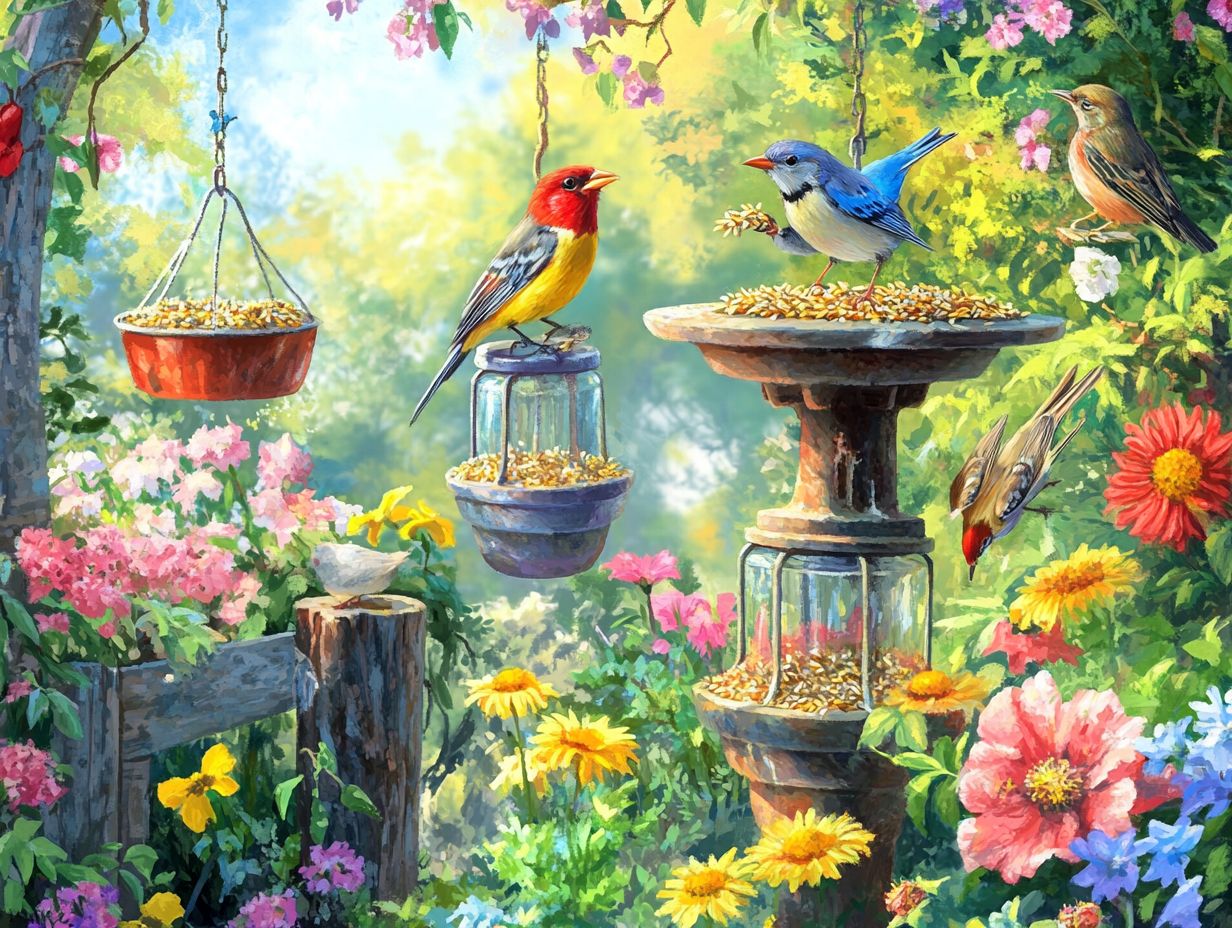
Different bird species have their favorites when it comes to feeders. Understanding these preferences can enhance your birdwatching experience.
To attract woodpeckers and nuthatches, invest in suet feeders. They offer high-energy fat, perfect for these active birds.
If finches and chickadees are on your wish list, use tube feeders filled with small seeds. Their agile feet allow them to perch easily and grab nutritious treats.
Doves and ground feeders prefer platform feeders for comfortable foraging. Position your feeders strategically to maximize bird visits in your backyard.
Tips for Attracting Birds to Your Feeder
To attract birds to your feeder, use key strategies. Create a welcoming environment that encourages frequent visits from various bird species.
Incorporate a variety of food options and maintain a safe distance from predators. These tactics enhance your backyard wildlife experience.
Creating a Welcoming Environment
Creating a friendly space for birds involves adding safe cover, food sources, and nesting materials. This approach attracts a delightful variety of bird visitors.
Consider installing bird feeders with seeds favored by local species, like sunflower or thistle. This simple addition invites them for a snack!
Add water features like birdbaths or small ponds. These not only attract thirsty birds but also give them a safe place to bathe.
When landscaping, choose a mix of shrubs, trees, and ground cover. Use native plants suited to your region for shelter and food local birds need.
Offering a Variety of Foods and Feeders
Offering a range of foods and feeders attracts many bird populations. Learn about the food preferences of different bird species to create a cherished haven.
This variety can include seeds, nuts, and suet, chosen to satisfy the cravings of finches, woodpeckers, and sparrows. Use specific feeder designs to enhance accessibility.
As seasons change, so do bird behaviors. Update the types and locations of food regularly to craft an inviting sanctuary celebrating local wildlife.
Frequently Asked Questions
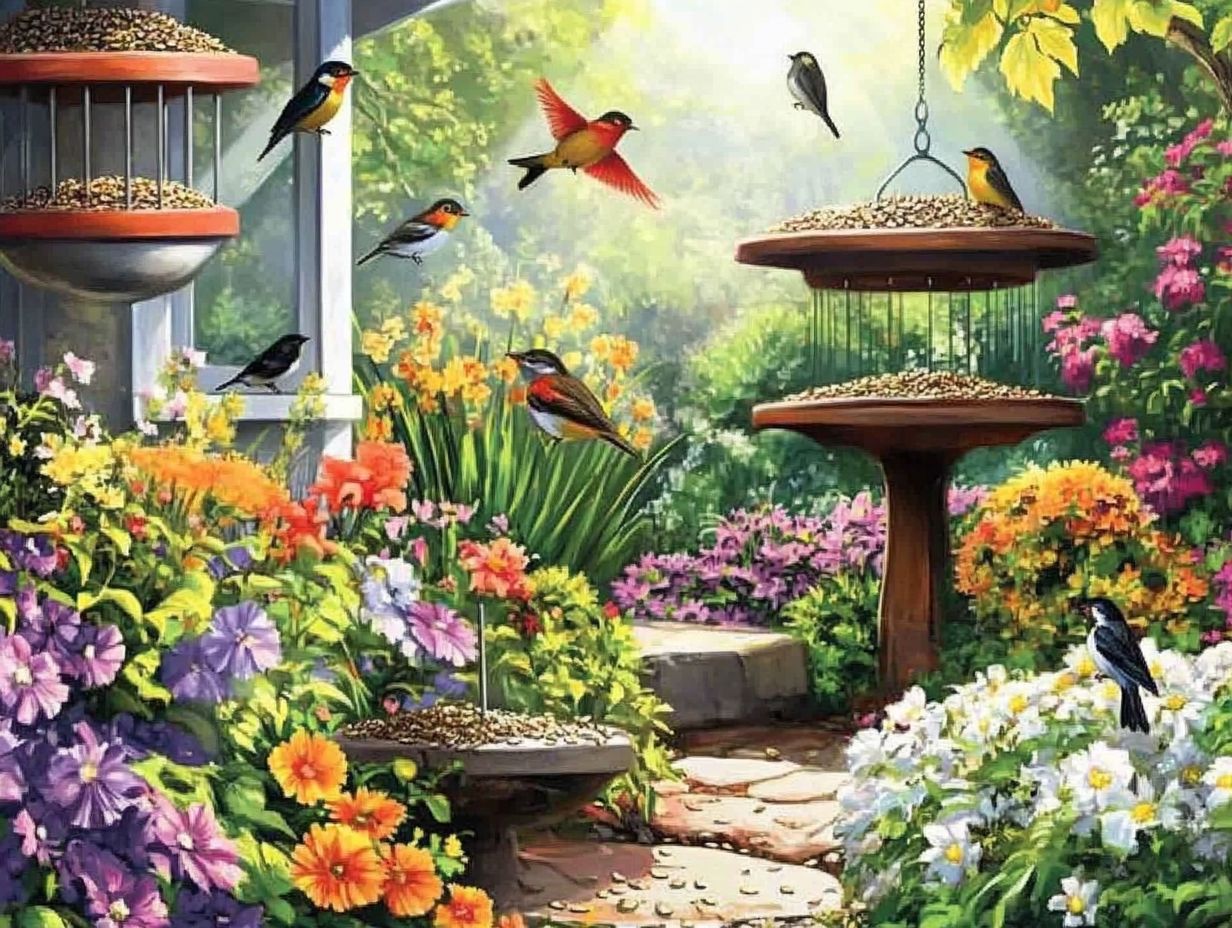
What factors should I consider when understanding bird feeder preferences?
Consider the types of birds in your area, the feeder’s location, the food you offer, and the feeder’s design.
Do Different Bird Species Have Specific Feeder Preferences?
Yes, bird species have specific feeder preferences. Some prefer platform feeders, while others like tube or hopper feeders. Research the preferences of local birds.
What Types of Food Should I Offer in My Bird Feeder?
The most common types of food for bird feeders include seeds, suet (a high-calorie food made from animal fat), nectar, and fruit. Offering a diverse range of food will attract a colorful mix of birds!
Can the Location of My Bird Feeder Affect Its Popularity?
Yes, where you place your feeder greatly impacts its popularity among birds. Position it in an open area, away from predators and sheltered from harsh weather.
How Can I Make My Bird Feeder More Appealing to Birds?
You can enhance your feeder’s appeal by adding perches, shelter, and water. Regularly cleaning and refilling the feeder keeps it stocked with fresh food.
Are There Any Specific Design Features I Should Look for in a Bird Feeder?
Yes, consider features like proper drainage, ease of cleaning, and durability. Also, choose a feeder with openings suited for the birds you want to attract.

